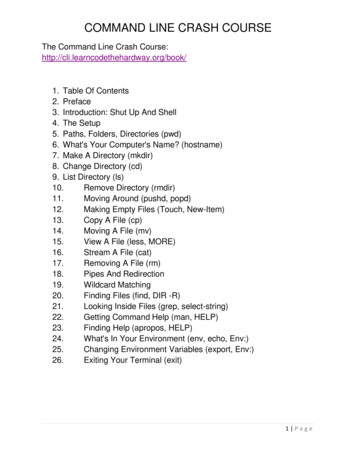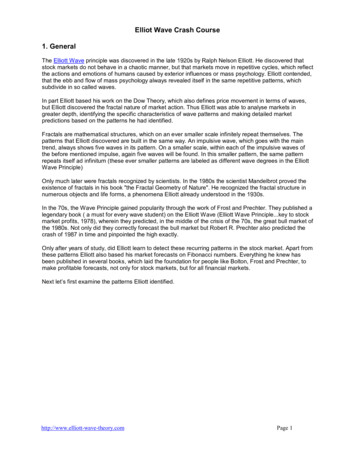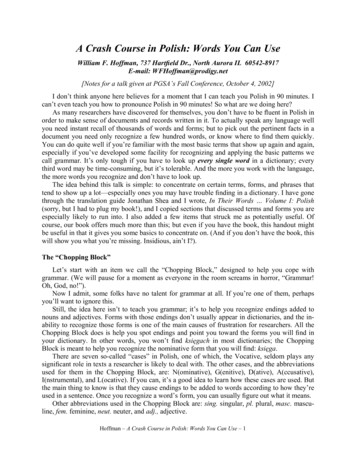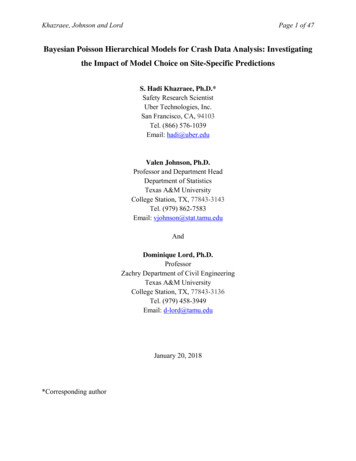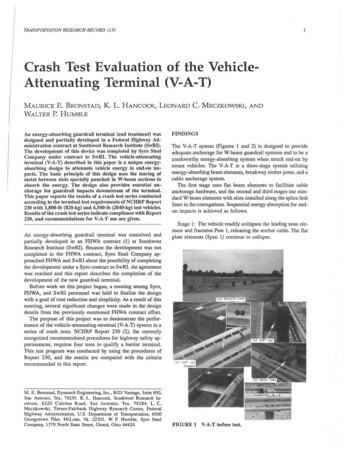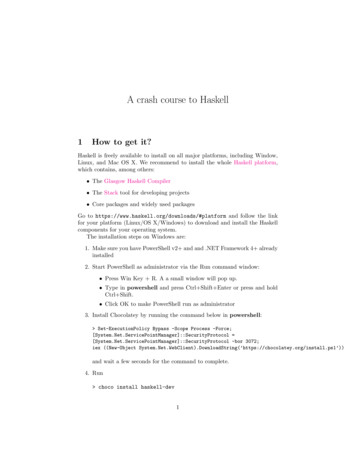
Transcription
A crash course to Haskell1How to get it?Haskell is freely available to install on all major platforms, including Window,Linux, and Mac OS X. We recommend to install the whole Haskell platform,which contains, among others: The Glasgow Haskell Compiler The Stack tool for developing projects Core packages and widely used packagesGo to https://www.haskell.org/downloads/#platform and follow the linkfor your platform (Linux/OS X/Windows) to download and install the Haskellcomponents for your operating system.The installation steps on Windows are:1. Make sure you have PowerShell v2 and and .NET Framework 4 alreadyinstalled2. Start PowerShell as administrator via the Run command window: Press Win Key R. A a small window will pop up. Type in powershell and press Ctrl Shift Enter or press and holdCtrl Shift. Click OK to make PowerShell run as administrator3. Install Chocolatey by running the command below in powershell: Set-ExecutionPolicy Bypass -Scope Process rotocol [System.Net.ServicePointManager]::SecurityProtocol -bor 3072;iex ((New-Object ocolatey.org/install.ps1’))and wait a few seconds for the command to complete.4. Run choco install haskell-dev1
You may be asked to confirm many installation steps by pressing Y5. Run refreshenvYou may need to restart powershell, before being able ro run the command ghcito run the GHC interactive environment.2How to work with Haskell?We will use the GHCi to initiate Haskell sessions, load and execute programs.GHCi stands for GHC interactive environment. It is a command-line toolthat can be started by typing ghci at the command prompt: ghciGHCi, version 8.4.3: http://www.haskell.org/ghc/Prelude :? for helpGHCi works in the Read-Eval-Print (REPL) mode: it performs repeatedly thefollowing sequence of operations:1. It waits for us to type a definition, expression, or command. After wesubmit it (usually, by pressing Enter), the input is read and evaluated.2. The result of evaluating an expression is printed.The evaluation of a definition does not produce output (therefore nothingis printed), but it adds a binding to the environment.GHCi commands have side effects too (see subsection below).3. The input prompt is shown again, to indicate that GHCi is waiting foranother input.Example: x 3 x 2 211-- a definition that binds x to 2; nothing to print-- compute the value of x2 2; print 11Haskell recognizes comments: they start with ’--’ and extend to the endof line. Comments are used to document the written code, and are ignored(not read) by GHCi.Documentation about how GHCi works is available online: click here2
3Haskell programsA Haskell program is a text file consisting of a group of definitions grouped ina module. We can use any text editor to write Haskell programs. A Haskell programfor a module Name should be named Name.hs. This is similar to thenaming convention in Java: the source file of a class C should be namedC.java The simplest structure of a source file for a module N ame ismodule N ame wheredef inition1.def initionnDefinitions are of the following kinds: Definitions which name expressions of different types, including functions.Examplesx::Integerx 1-- if omitted, the type declaration is computed gy GHCiintsFrom::[Integer]- [Integer]intsFrom x x:intsFrom (x 1)nats intsFrom 1 -- GHCi will infer that nats::[Integer] Definitions of type classes, algebraic types, and type aliases (Lecture 6).4GHCi commandsThe most important GHCi commands are::load N ame reads definitions of module N ame from file N ame.hs:quit quits the current working session with Haskell.:type expr prints the type of expr without evaluating it.:set t sets GHCi to show the type of each variable bound by a statement. For example: (x:y:xs) "abcdefgh"x :: Charxs :: [Char]y :: Char3
5Useful predefined operationsFor Integer arithmeticRelational operatorsThere are ordering and (in(equality relations over the integers, as there are overall basic types. These functions/operators take 2 integers as input and returna Bol, that is either True or False. The relations areFloating-point numers: FloatLiteral floats in Haskell can be given by decimal numerals, such as3.141592-34.25567.12316.0The numbers are called floating point because the position of the decimal pointis not the same for all Floats; depending upon a particular number, more ofthe space can be used to store the integer or the fractional part.Haskell also allows literal floating-point numbers in scientific notation. Thesetake the form below, where their values are given in the right-hand column ofthe table:4
This notation is more convenient than the decimal notation for very large andsmall numbers. Haskell provides a range of operators and functions over Float:6Getting startedThe goal of Lab 5 is to illustrate a new style of functional programming,called lazy programming. This programming style is supported by languages that implement the lazy evaluation strategy, or its optimized version called call-by-need evaluation. Haskell is a language for functionalprogramming which implements the call-by-need evaluation strategy.5
In lazy evaluation, the arguments of a function call are evaluated only iftheir value is needed to compute the overall result. Moreover, if an argument isstructured (a list or a tuple), only those parts of the argument which are neededwill be computed.Lazy evaluation has consequences on the style of programs we can write.Since an intermediate list will only be generated on demand, using partiallygenerated intermediate list can reduce significantly the overall cost of computation We will illustrate this programming style with a series of examples.6.1Lazy programmingOur first Haskell program is a text file HLab1.hs with the following content:module HLab1 whereintsFrom::Integer- [Integer]intsFrom x x:intsFrom (x 1)-- type declaration-- definitionnats::[Integer]nats intsFrom 1-- type declaration-- definition(During the lab, we will extend this program with new definitions.) This program contains two definitions, for variables intsFrom and nats. Definitions arepreceded by type declarations of the formname::typewith the intended reading “name has type type”. Often, Haskell can computethe types of the variables that get defined. If this is the case, we can omit thetype declaration. For example, the ghci command :type intsFrom 1intsFrom 1 :: [Integer]indicates that Haskell can compute the type of intsFrom 1, which is [Integer].This computation is called type inference, and does not evaluate the expression intsFrom 1.In lazy programming (including Haskell), the evaluation of a definitionname expradds a binding of name to expr to the top frame of the evaluation environment. This is different to what happens in strict functional programming(including Racket), where name is bound to the value of expr.For example, the evaluation of the definitionsintsFrom x x:intsFrom (x 1)nats intsFrom 16
extends the top frame of the evaluation environment with two bindings, asillustrated below:intsFromλx.(x : intsFrom (x 1)) natsintsFrom 1.top frame of the evaluation environmentIn strict functional programming, the previous two definitions would be writtenas(define (intsFrom x) (cons x (intsFrom ( x 1))))(define nats (intsFrom 1))The first definition will add the same binding to the top frame, but the seconddefinition will crash the system (stack overflow) because Racket will try tobind nats to the value (intsFrom 1), and the evaluation of (intsFrom 1)is nonterminating and does not display anything:(intsFrom 1) (cons (1 (intsFrom 2)) . intsFrom is bound to a function.intsFrom x computes the infinite list [x, x 1, x 2, . . .] nats is bound to an expression whose evaluation produces the infinite listof all integers starting from 1: [1,2,3,.]If we ask Haskell to compute the value of intsFrom 1, it performs the sameinfinite computation like Racket:intsFrom 1 1:(intsFrom 2) 1 : 2 : (intsFrom 3) .but Haskell will display the elements of the list as soon as they are generated: intsFrom 1[1,2,3,4,.The computation can be interrupted by pressing Ctrl-C.nats is an example of defining an infinite data structure in lazy programming. The attempt to compute its complete value will run forever, but we canstill use it in computations that need only finite portions of the structure ratherthan the whole value. The following examples illustrate such computations.Getting the first n elements of an infinite listHaskell has the built-in function take n lst which takes as inputs an integern 1 and a list lst, and returns the list of first n elements of lst. If lst hasless then n elements, then take n lst returns lst. The function take is easyto define by recursion on n:7
take n (ntaketake n 0) []-- taking n 0 elements from any list yields [][] [](x:xs) x:take (n-1) xsTo take the first 3 elements from nats, we must compute only the first 3 elementsof intsFrom 1. This is what call-by-need evaluation does: take 3 nats[1,2,3]becausetake 3 nats take 3 (intsFrom 1)take 3 (1:intsFrom 2)1:take 2 (intFrom 2)1:take 2 (2:intsFrom 3)1:2:take 1 (intsFrom 3)1:2:take 1 (3:intsFrom 4)1:2:3:take 0 (intsFrom 4)1:2:3:[] [1,2,3]-- need an element-- get an element-- need an element-- get an element-- need an element-- get an element-- stopQuizConsider the following definitions:sieve1,sieveAll:[Integer]- [Integer]sieve1 (x:xs) x:filter (\y- (mod y x) 0) xssieveAll (x:xs) x:sieveAll (filter (\y- (mod y x) 0) xs)With list comprehensions (see Lecture Notes 5), the previous definitionscan be rewritten in the more readable but equivalent formsieve1 (x:xs) x:[y y -xs, y ‘mod‘ x 0]sieveAll (x:xs) x:sieveAll [y y -xs, y ‘mod‘ x 0]1. What does sieve1 [n.] compute for n N, n 1?Suggestion: check the results returned by take 10 (sieve1 [n.]) forn {2, 3, 4}2. What does sieve1 [1.] compute? Does the computation terminate?3. What does sieveAll [2.] compute?Suggestion: add these definition to program HLab1.hs, reload it with command:load HLab1and test them.8
1. sieve1 [n.] computes the infinite list of Integers from n, without themultiples of n which are different from n. It is a nonterminating computation, For example: sieve1 [2.][2,3,4,5,6,.2. sieve1 [1.] is a nonterminating computation of a list. It does notdisplay anything because it runs indefinitely trying to find and display anonexisting n 1 such that mod n 1 0. Only the first element, whichis 1, gets computed.3. sieveAll [2.] computes the infinite list of all prime numbers: sieveAll [2.][2,3,5,7,11,13,17,19,23,.Thus, we can defineprimes sieveAll [2.]and use it to get finite portions of prime numbers. For exampletake 2 primesgenerates and gets only the first two prime numbers, because that is all we need:-- need an elementtake 2 primes take 2 (sieveAll [2.]) take 1 2:sieveAll [y y -[3.],y ‘mod‘ 2 0] -- get an element 2:take 1 sieveAll [y y -[3.],y ‘mod‘ 2 0] -- need an element 2:take 1 3:sieveAll [y y -[4.],.]-- get an element 2:3:take 0 sieveAll [y y -[4.,.]]-- stop 2:3:[] [2,3]6.2Proposed exercisesThe following exercises will be discussed during the next lab.1. Define recursively the function map2::(a- b- c)- [a]- [b]- [c]such that, if f is a binary function that takes inputs of types a and b, and computesresult of type c, lst1 [a1 , . . . , an ] is a list of n elements of type a, lst2 [b1 , . . . , bn ] is a list of n elements of type bthen (map2 f lst1 lst2) computes the list [c1 , . . . , cn ] where ci is thevalue of (f ai bi ) for all 1 i n. For example:9
map2 ( ) [1,2,3] [4,5,6][5,7,9] map2 (*) [1,2,3] [4,5,6][4.10,18]2. Use map and addLists to define the infinite list of IntegersyList [y1 , y2 , y3 , . . .]22where y1 y2 1, y3 2 and yn yn 1 2 · yn 2 3 · yn 3 for all n 3.3. Define the function nestList::(Double- Double)- Double- [Double]such thatnestList f vcomputes the infinite list[v, f v, f (f v),f (f (f v)),.]4. Consider the function g defined bynwtList a let g x (x a/x)/2 -- same as g \x.((x a/x)/2)in nestList g 1.0This definition extends the top frame of the evaluation environment Ewith the binding for nwtList, as shown below:EnwtListλa.(nestList g 1.0) nestList.λf.λv. · · ·gλx.((x a/x)/2) (a) What is the value of nwtList 5.0? Does the computation terminate?(b) What is the value ofhead (take 5 nwtList 7.0)Does the termination terminate?Suggestion: remember Newton’s method to computeitive real number. x when x is a pos-5. Consider the function definitiontriples::Int- [(Int,Int,Int)]triples n [(a,b,n-a-b) a -[1.n-2],b -[1.n-1-a]]What is the value of the function call (triples n) when n 2?Suggestion: use ghci to compute the values of (triples n) for somesmall values n 2, to see what you get.10
6. Define recursively the function allTriples::Int- [(Int,Int,Int)] suchthat, if n 0, then (allTriples n) returns the list of all triples (a, b, c)with a 0, b 0, c 0 and a b c n.7. Define the list t3List of all triples (a, b, c) of type (Int,Int,Int) witha 0, b 0, c 0.Suggestion: Define recursively the recursive functiontriplesFrom nwhich generates the list of all triples (a, b, c) of type (Int,Int,Int) witha 0, b 0, c 0 and a b c n.8. A Pythagorean triple is a triple (a, b, c) of strict positive integers such thata2 b2 c2 . Define the function (pythTriples n) which returns the firstn Pythagorean triples from t3List.6.3Miniproject 1Power series have many applicationsin sciences and engineering. We considerP power series of the form n 0 an xn with an R for all n 0, and representthem by infinite lists of Doubles. For exampleEx. 1) Xxn is represented by the list comprehension [1.]n 0Ex. 2) ex Xxncan be represented byn!n 0eRepr map (\x- 1/fromInteger x) (coeffList [1.] 1 (*))wherecoeffList::[Integer]- a- (I
1.Make sure you have PowerShell v2 and and .NET Framework 4 already installed 2.Start PowerShell as administrator via the Run command window: Press Win Key R. A a small window will pop up. Type in powershell and press Ctrl Shift Enter or press and hold Ctrl Shift. Click OK to make PowerShell run as administrator




